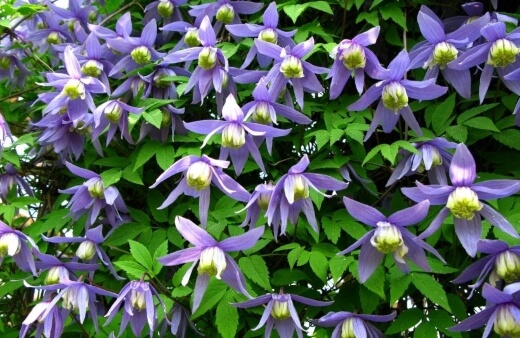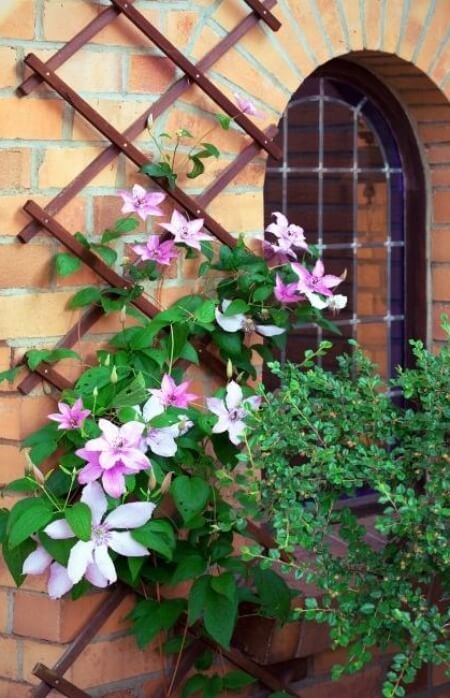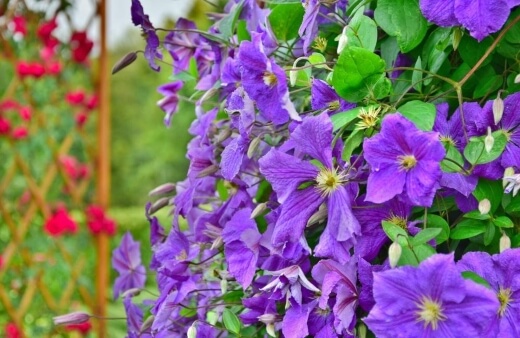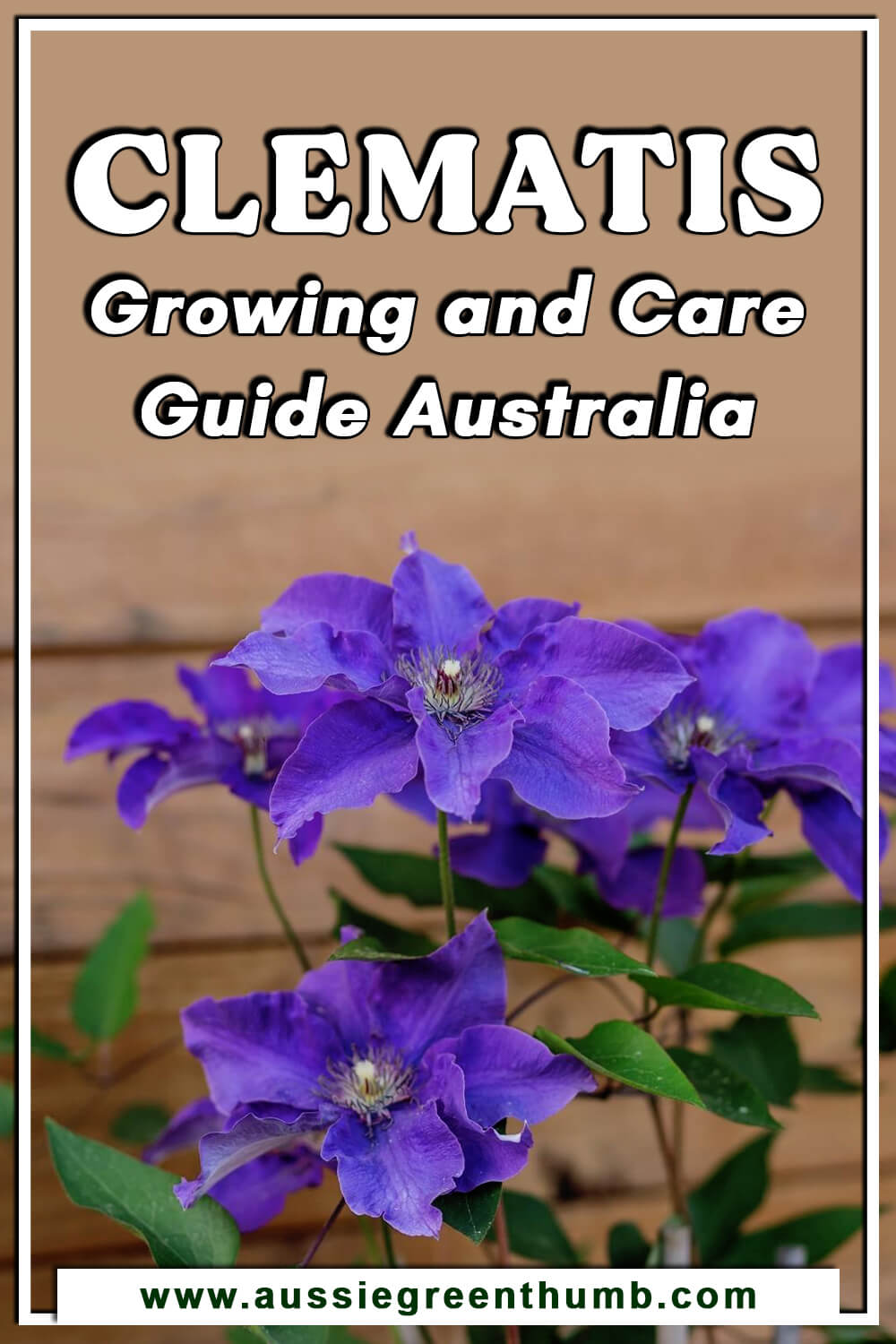Clematis is a flowering vine that pops with colour, and is surprisingly low maintenance. The beautiful blooms can grow up to 15cm in size, and you will be spoilt for choice with the varieties available.
Read on if you want to know how to plant, propagate and care for Clematis for your garden.
More...
Genus: | Clematis |
|---|---|
Family: | Ranunculaceae |
Common Names: | Leatherflower |
Plant type: | Flowering vine |
Growth rate: | Depends on variety |
Size: | Flowers can be between 10 and 15cm |
Sun requirements: | Full sun |
Soil type: | Well-drained, neutral to slightly acidic |
Flower colour: | Pink, purple, white |
Maintenance level: | Low |
Poisonous for pets: | Yes |
Introducing the Clematis

Clematis is known as quite the climber. It can happily travel up trellises, and through other plants. It blooms from early summer through to autumn, and produces flowers that look like stars in white, pink, red, blue or purple.
Clematis vines flower at different times during summer. Some of the varieties flower early, some late and others bloom on and off throughout the growing season. If you grow two or more varieties next to each other, you can plan to have a display of flowers for a long period of time.
Clematis is a genus of about 300 species that belong to the buttercup family, Ranunculaceae, the same family as Hepaticas. Their popularity among garden lovers dates back to the 1860s and more hybrid cultivars are being produced all the time, mainly of Chinese and Japanese origin.
Most of the species are known as Clematis in English. Some are also called traveller's joy, virgin's bower for Clematis terniflora, Clematis virginiana, and Clematis viticella and old man's beard for those with prominent seedheads. This plant is known as leather flower for those with fleshy petals.
Features of the Clematis

These vines are often chosen for the garden because of their wide range of bright colours and interesting flower shapes. They come in both single and double flower forms and look great as a border plant.
Clematis vines are hardy, but how much will depend on where it’s planted and the type. The vine’s growth rate and mature height also depends on the types of clematis planted. Although there are many varieties, the growing conditions needed are mostly the same.
This plant likes a location that receives full sun, although their roots prefer a cool and shaded area. This vine works great when planted with other ornamental perennial shrubs, something like hydrangeas. Some of the clematis varieties produce climbing vines, and some grow upwards using tendrils.
How to Grow Clematis

Planting Clematis
This plant don’t like to be moved, so be sure to choose a permanent location when you plant them. You need to plan ahead for supporting the vine as they cope best when they are encouraged to climb up a trellis, arbour or another structure.
Start off by loosening the soil to a depth of about 30cm and mix in about 6 cups of compost and ¼ to ½ cup of all-purpose granular fertiliser.
Dig a hole deeper than the root ball, and place the crown of the plant (where the roots meet the stem) about 5cm below the soil and refill the hole. If the plant is sprouting, you shouldn’t be able to see the growing tips above the surface.
A newly planted clematis vine needs time to settle and it usually takes two growing seasons for them to reach their full flowering size. If the vine needs a little help attaching to a trellis or structure you can use soft twine or waxed string to attach the vines and offer extra support.
Where to Plant Clematis
Clematis vines grow up and not out. This means they occupy very little soil space in the garden. You can easily make room for them, even in a small garden. Since they can grow to a height of 4.5 metres, be sure to give them something to climb on or over.
Some varieties are less likely to climb, but most of them have twining leaf stems that they use to attach themselves to trellises or other plants. The leaf stems are quite short, so aim for a trellis with narrow slats or a wire grid that's easy to grip.
How to Care for Clematis

Clematis Light Requirements
Clematis will grow in partial shade, but they flower best in full sun. Try and make sure the top of the plant is in the sun and that the root zone is shaded by other plants.
Watering Leather Fower
During the first growing season, it should be watered whenever the weather is dry. If you add mulch around the base of the plant it will help retain moisture and keep the roots cool.
Pruning
After the flowers wilt, some develop beautiful seed heads. It’s not a must, but you can also cut off the seed heads to keep the plant looking good. If you think your clematis could bloom again, you can remove just the expired flower heads, and don’t cut back the foliage.
Early spring is the best time to prune a clematis. For the varieties that produce new growth on last year’s vines, only prune to shape the plant. Other varieties die back during winter, and all new growth comes from the base of the plant.
With this type of clematis, all of the vines from the previous year can be cut off in early spring. Not sure which type of clematis you have? You can just wait until the plant sprouts new growth and check where it's coming from. Then you can prune accordingly.
If your clematis outgrows its space, you can control the growth by cutting back the entire plant to a height of about 13 cm and this can be done in autumn or early spring. You can also trim back any stray vines during the growing season.
It is essential for you to use a reliable cutting tool so be sure to check our pruning shears buying guide for 2023.
What Fertiliser to Use
Fertilise clematis in the spring when the first leaves start to unfold. The ideal choice would be a balanced fertiliser, something like a 10-10-10 or a lower nitrogen type like 5-10-5.
This provides a steady feed. If you want to boost flowers, you can alternate between the lower-nitrogen fertiliser with a balanced liquid fertiliser every 4-6 weeks during the growing season.
While caring for your plants and garden, be sure to care for yourself too, by making sure you have the right gardening attire. We’ve rounded up a list of the best shoes, hats, gloves, and overalls to get you started.
Propagating Clematis

There are a few different way to propagate a clematis:
- Grow clematis from seed but it’s a very slow process taking up to 3 years for germination
- Divide and transplant mature plants
- Layering – this is when the stem of a living vine is pinned to the ground until it grows strong roots
- Growing a new plant from cuttings – this is a quick and easy process but not all of the cuttings will root
It is possible to grow clematis from stem cuttings from late spring until the end of summer.
The cuttings have different names depending on their maturity. They are:
- Spring: softwood
- Summer: semi-ripe
- Late summer: ripe
- Autumn: hardwood
Some gardeners find they have the most success using late spring and early summer cuttings because once the cutting is rooted, there is still plenty of warmth, light, and time to nurture them.
The newer and greener cuttings are more tender and cuttings later in the season are tougher but take longer to root themselves.
No propagation method ever has a 100 percent success rate unfortunately. It’s best to prep 10 to 12 pieces, taken from about 3 long cuttings. You will then hopefully end up with 3 to 6 plants for the garden.
Clematis Propagation Process
We’ll stick with the suggestion of taking a softwood cutting in late spring or early summer. Choose a vine that is two years or older to get your cutting.
Don’t cut the super fine new growth of spring, but rather wait a few weeks into the growing season when the growth starts to thicken. You don’t want stems with buds or flowers.
Take a look at the stem before you cut it. You’ll notice at the base of the plant that the stem is woodier, and might be turning brown. The tips where you find new growth are the greenest parts.
Start by taking a long piece of stem and divide it into several cuttings. You need to be ready to pot them straight away. To take the cutting, cut just above a leaf joint. This is the part of the stem where two leaves grow from.
You need to quickly place the cut end between warm, damp paper towels, and place in a bag. This helps reduce the shock to the cutting. Place the cutting on a cutting board and put the top of the vine, the green end, at the top of the board.
Starting at the first leaf joint from the bottom, you are going to cut 2.5cm above the leaf joint, cut off the leaf on the left side, and then cut 5 cm below the leaf joint. You now have your first piece for propagation.

Next, you’re going to place a small amount of rooting hormone in a dish, dip the stem in powder, and then tap off the excess. To prevent contamination, don’t dip directly in the rooting hormone container.
Use a chopstick to make an insertion hole in the potting mix for each cutting. Once you have added the rooting hormone, you can place the cuttings in the potting soil and lean it against the inner side of the pot.
Cover the stem with rooting hormone on it with potting soil, and press down lightly to remove any air pockets. You can put 4 cuttings in one pot, one against each inner side.
The growing medium needs to be damp enough to maintain a ball shape if you squeezed it together, but it shouldn’t be dripping water.
Cover your cuttings if the air is dry and there is risk of the cuttings drying out, otherwise you can just keep them in a warm place away from direct sun.
You need to check your plants every day to make sure the moisture levels are consistent. You don’t want too much or too little moisture, otherwise mould and mildew can form.
In about 2-4 weeks, you should see new roots forming and you can then put the plants in individual pots. If you want to test for new root growth, you can look at the holes in the bottom of the pot for any signs of life. You could also pull gently on the plant from the base near the soil.
If it feels like there is some resistance when you pull, you’re on the right track. Any new growth above the soil shows that the plant is growing as it needs to. You can give your plant time to grow bigger and keep it indoors until spring.
If you’re one of those gardeners who like to keep their tools, pots and other garden items neatly stored, why not check out our Australian Buying Guide for the best garden sheds.
Pests and Diseases that Affect Clematis
Clematis can be prone to "wilt", a fungal disease that gets into the plant at the soil line. It can cause all or some of the plant's leaves and stems to suddenly turn black.
Although the disease damages the plant for the current growing season, in most cases the plant will return the following year. There is no way to prevent or cure wilt. If it does strike, you will need to cut off and prune any affected stems and leaves.
Remember to clean your cutting tool to avoid cross infection. Some insect pests feed on clematis leaves and damage them. These include earwigs and caterpillars.
If you notice that the young leaves look torn and are full of small, brown-edged holes, you might be dealing with these bugs. Slugs and snails are also common pests that feed on this plant.
If you are dealing with clematis bugs, they can be easily removed by a strong spray of water or you can cut off heavily infested leaves. By pruning away these infested branches, it can help prevent the pests from spreading to other parts of the plant or garden.
For the foliage hungry caterpillars, you can also pick off these pest populations before they strip the clematis of its leaves.
Here is a more positive spin on natural pests. They are sometimes a great defence that works in your favour. Parasitic wasps, ladybugs and lacewings actually eat the smaller pests.
If the unwelcome visitors are still in the way, you can spray your plant thoroughly with a ready-to-use insecticidal soap or neem oil. Just be sure you coat all the leaf surfaces.
Clematis Frequently Asked Questions

How fast does a clematis grow?
Once the vine is established, this plant can grow with great enthusiasm. Each variety grows at a different speed, but the plants can grow anywhere from 1 to 6 metres in a year.
Where does the name clematis come from?
The name Clematis comes from the Greek word “klematis,” meaning vine.
Do the clematis have any special uses?
The leaves and seeds of the Clematis ligusticifolia were once used as a black pepper substitute when black pepper was very rare and expensive. Clematis vines are flexible, which makes them perfect for making wreaths.
What happens if you eat clematis?
All parts of the plant are considered toxic if eaten and it can cause a severe burning sensation and ulcers in the mouth.
Does the clematis have any medicinal properties?
In the past, the leaves were thought to cure leprosy.
Does clematis have a scent?
While many varieties are fragrant, especially those with smaller flowers, the scent of almonds is strongest in the evergreen varieties. Only a few of the deciduous purple-flowered varieties have an almond scent.
What is clematis used for?
Clematis is considered herbal and people use the parts that grow above the ground to make medicine. This plant is used for joint pain (rheumatism), headaches, varicose veins, gout, bone disorders, ongoing and fluid retention, although its safe use has not been confirmed.

Elevate Your garden with the Enchanting Allure of Clematis
Clever is not a word that you might easily use to describe a plant. In the case of the clematis, it seems appropriate. The ability of this vine to grow and spread itself across and through other plants, and garden structures, makes it interesting and desirable.
The flowers are beautiful, some are fragrant, and if you strategically plant a few clematis that bloom at different times, you can secure a part of your garden that will always have a splash of colour.
Once you have perfected the art of taking a cutting, you are well on your way to successful propagation of the vine, which will happily redecorate a structure that you give it (with style and determination). We are quite taken with the clematis and happy to give it our green thumbs up!
Published on March 28, 2022 by Maisie Blevins
Last Updated on February 21, 2024




